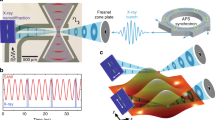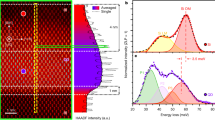Abstract
Knowledge about strain at the nanometre scale is essential for tailoring the mechanical and electronic properties of materials. Flaws, cracks and their local strain fields can be detrimental to the structural integrity of many solids1,2. Conversely, the controlled straining of silicon can be used to improve the performance of electronic devices3,4,5. Here, we demonstrate that infrared near-field microscopy6 allows direct, non-invasive mapping and a semiquantitative analysis of residual strain fields in polar semiconductor crystals with nanometre-scale resolution. Our experiments with silicon carbide crystals yield optical images of nanoindents showing strain features as small as 50 nm and the evolution of nanocracks. In addition, by imaging nanoindents in doped silicon, we provide experimental evidence for plasmon-assisted near-field imaging of free-carrier properties in nanoscale strain fields. Near-field infrared strain mapping provides possibilities for nanoscale material and device characterization, and could become a tool for nanoscale mapping of the local free-carrier mobility in strain-engineered semiconductors.
This is a preview of subscription content, access via your institution
Access options
Subscribe to this journal
Receive 12 print issues and online access
$259.00 per year
only $21.58 per issue
Buy this article
- Purchase on Springer Link
- Instant access to full article PDF
Prices may be subject to local taxes which are calculated during checkout



Similar content being viewed by others
References
Wang, Y. D. et al. The development of grain-orientation-dependent residual stress in a cyclically deformed alloy. Nature Mater. 2, 101–106 (2003).
Poulsen, H. F., Wert, J. A., Neuefeind, J., Honkimaki, V. & Daymond, M. Measuring strain distributions in amorphous materials. Nature Mater. 4, 33–36 (2005).
Ieong, M., Doris, B., Kedzierski, J., Rim, K. & Yang, M. Silicon device scaling to the sub-10-nm regime. Science 306, 2057–2060 (2004).
Vogel, E. M. Technology and metrology of new electronic materials and devices. Nature Nanotech. 2, 25–32 (2007).
Hytch, M., Houdellier, F., Hüe, F. & Snoeck, E. Nanoscale holographic interferometry for strain measurements in electronic devices. Nature 453, 1086–1089 (2008).
Hillenbrand, R., Taubner, T. & Keilmann, F. Phonon-enhanced light–matter interaction at the nanometre scale. Nature 418, 159–162 (2002).
Tamura, N. et al. High spatial resolution grain orientation and strain mapping in thin films using polychromatic submicron X-ray diffraction. Appl. Phys. Lett. 80, 3724–3726 (2002).
Zhu, W. L., Wan, K. S. & Pezzotti, G. Methods of piezo-spectroscopic calibration of thin film materials: II. Tensile stress field at indentation crack tip. Meas. Sci. Technol. 17, 191–198 (2006).
Boyd, I. W. & Wilson, J. I. B. Silicon–silicon dioxide interface—an infrared study. J. Appl. Phys. 62, 3195–3200 (1987).
Becker, M., Scheel, H., Christiansen, S. & Strunk, H. P. Grain orientation, texture and internal stress optically evaluated by micro-Raman spectroscopy. J. Appl. Phys. 101, 063531 (2007).
Novotny, L. & Hecht, B. Principles of Nano-Optics (Cambridge Univ. Press, 2006).
Ocelic, N., Huber, A. & Hillenbrand, R. Pseudoheterodyne detection for background-free near-field spectroscopy. Appl. Phys. Lett. 89, 101124 (2006).
Ocelic, N. & Hillenbrand, R. Subwavelength-scale tailoring of surface phonon polaritons by focused ion-beam implantation. Nature Mater. 3, 606–609 (2004).
Huber, A., Ocelic, N., Taubner, T. & Hillenbrand, R. Nanoscale resolved infrared probing of crystal structure and of plasmon–phonon coupling. Nano Lett. 6, 774–778 (2006).
Huber, A. J., Kazantsev, D., Keilmann, F., Wittborn, J. & Hillenbrand, R. Simultaneous IR material recognition and conductivity mapping by nanoscale near-field microscopy. Adv. Mater. 19, 2209–2212 (2007).
Stockle, R. M., Suh, Y. D., Deckert, V. & Zenobi, R. Nanoscale chemical analysis by tip-enhanced Raman spectroscopy. Chem. Phys. Lett. 318, 131–136 (2000).
Hartschuh, A., Sanchez, E. J., Xie, X. S. & Novotny, L. High-resolution near-field Raman microscopy of single-walled carbon nanotubes. Phys. Rev. Lett. 90, 095503 (2003).
Yano, T. A., Inouye, Y. & Kawata, S. Nanoscale uniaxial pressure effect of a carbon nanotube bundle on tip-enhanced near-field Raman spectra. Nano Lett. 6, 1269–1273 (2006).
Saito, Y., Motohashi, M., Hayazawa, N., Iyoki, M. & Kawata, S. Nanoscale characterization of strained silicon by tip-enhanced Raman spectroscope in reflection mode. Appl. Phys. Lett. 88, 143109 (2006).
Schmidt, U., Ibach, W., Muller, J., Weishaupt, K. & Hollricher, O. Raman spectral imaging—a nondestructive, high resolution analysis technique for local stress measurements in silicon. Vibr. Spectrosc. 42, 93–97 (2006).
Karch, K., Bechstedt, F., Pavone, P. & Strauch, D. Pressure-dependent properties of SiC polytypes. Phys. Rev. B 53, 13400–13413 (1996).
Kehr, S. et al. Anisotropy contrast in phonon-enhanced apertureless near-field microscopy using a free-electron laser. Phys. Rev. Lett. 100, 256403 (2008).
Liu, J. & Vohra, Y. K. Raman modes of 6H polytype of silicon-carbide to ultrahigh pressures—a comparison with silicon and diamond. Phys. Rev. Lett. 72, 4105–4108 (1994).
Schneider, S. C., Grafström, S. & Eng, L. M. Scattering near-field optical microscopy of optically anisotropic systems. Phys. Rev. B 71, 115418 (2005).
Brehm, M., Schliesser, A. & Keilmann, F. Spectroscopic near-field microscopy using frequency combs in the mid-infrared. Opt. Exp. 14, 11222–11233 (2006).
Huber, A. J., Keilmann, F., Wittborn, J., Aizpurua, J. & Hillenbrand, R. Terahertz near-field nanoscopy of mobile carriers in single semiconductor nanodevices. Nano Lett. 8, 3766–3770 (2008).
Quinn, G. D. & Bradt, R. C. On the Vickers indentation fracture toughness test. J. Am. Ceram. Soc. 90, 673–680 (2007).
Masetti, G., Severi, M. & Solmi, S. Modelling of carrier mobility against carrier concentration in arsenic-doped, phosphorus-doped and boron-doped silicon. IEEE Trans. Electron. Dev. 30, 764–769 (1983).
Huber, A., Ocelic, N., Kazantsev, D. & Hillenbrand, R. Near-field imaging of mid-infrared surface phonon polariton propagation. Appl. Phys. Lett. 87, 081103 (2005).
Cvitkovic, A., Ocelic, N. & Hillenbrand, R. Analytical model for quantitative prediction of material contrasts in scattering-type near-field optical microscopy. Opt. Exp. 15, 8550–8565 (2007).
Acknowledgements
The authors thank IKZ Berlin for providing SiC, NOVASiC (France) for SiC surface polishing, and N. Ocelic, F. Keilmann, J. Plitzko (all Martinsried) and M. Stutzmann (TU Munich) for stimulating discussions. Supported by the Deutsches Bundesministerium für Bildung und Forschung (BMBF) grant no. 03N8705 and the Basque Foundation for Science (Ikerbasque).
Author information
Authors and Affiliations
Contributions
A.J.H., A.Z. and R.H. conceived and designed the experiments. A.J.H. performed the s-SNOM experiments and A.J.H., A.Z. and R.H. analysed the data. T.K. performed the indentation experiments. A.J.H., A.Z. and R.H. wrote the manuscript. All authors discussed the results and commented on the manuscript.
Corresponding author
Rights and permissions
About this article
Cite this article
Huber, A., Ziegler, A., Köck, T. et al. Infrared nanoscopy of strained semiconductors. Nature Nanotech 4, 153–157 (2009). https://doi.org/10.1038/nnano.2008.399
Received:
Accepted:
Published:
Issue Date:
DOI: https://doi.org/10.1038/nnano.2008.399
This article is cited by
-
Manipulating polaritons at the extreme scale in van der Waals materials
Nature Reviews Physics (2022)
-
In situ plant materials hyperspectral imaging by multimodal scattering near-field optical microscopy
Communications Materials (2021)
-
Edge-oriented and steerable hyperbolic polaritons in anisotropic van der Waals nanocavities
Nature Communications (2020)
-
Soliton superlattices in twisted hexagonal boron nitride
Nature Communications (2019)
-
Near-field spectroscopic investigation of dual-band heavy fermion metamaterials
Nature Communications (2017)



